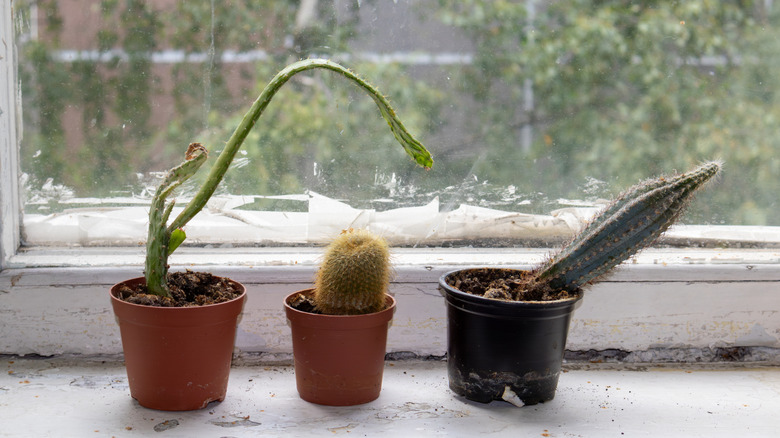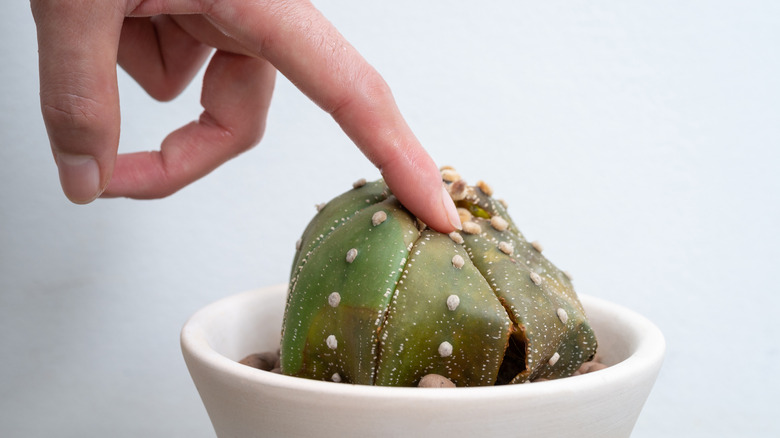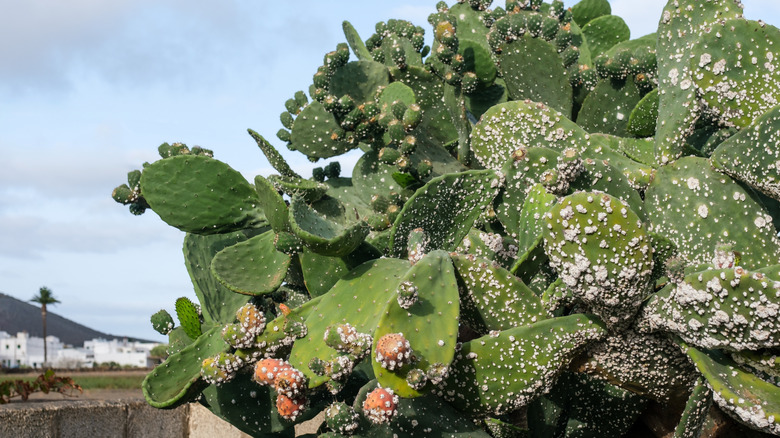Why Your Cactus Is Leaning (And How To Fix It)
Whether you're keeping an indoor cactus or an outdoor one, virtually every succulent owner has fallen victim to the dreaded cactus lean. You think you're doing absolutely everything right when caring for your cactus (after all, aren't they supposed to be easy plants to grow?), but one day you step outside and realize you've got a plant that's emulating the leaning tower of Pisa in your own backyard.
As with so many horticultural afflictions, there are a few things that can make a cactus tip to one side. You could have a pest problem, your cactus could be overwatered, or there could be an issue with your soil. Your cactus might even have contracted a plant disease or root rot. It's important to first determine exactly what's wrong with your plant before you start trying to treat it willy-nilly; these issues are all vastly different from one another, and require a totally different care plan if you really want to save your plant.
The good news is, a leaning cactus isn't a sign that it's on its last legs (or roots). In many cases, it's totally fixable. Here's how to figure out exactly what's wrong with your leaning cactus and how to take care of it.
Overwatering, light, and poor soil
There are a few issues that are relatively easy to fix that could cause your cactus to lean. The first has to do with the soil. If your cactus is leaning, it could simply not be getting enough support in the ground, causing its roots to rise and making the plant start to tip over. If you're working with an indoor cactus, you may want to repot it into a cacti-specific soil mix, making sure to gently pack the dirt down. Outdoors, you can simply add more soil around the cactus.
Your cactus could also be leaning because it's not getting enough sun. Cacti are desert plants, so they need a lot of sunlight to thrive; when they don't get enough sun, they'll start attempting to stretch out and grow towards it, causing them to grow super tall and skinny or lean to the side in search of sunlight. Check care instructions for your specific cactus to ensure it's getting the number of sunlight hours it needs. Indoors, move your cactus to an area where it can get enough sun, or add a grow light. Outdoors, you may want to try and replant it, or see if you can move something that might be shading it (such as an outdoor umbrella or canopy).
If your cactus is overwatered, it could start leaning. When a cactus is overwatered, it literally becomes top-heavy with all the fluid it's absorbing and keeping in its tissues. You'll probably notice other signs here, too, such as mushiness, yellowing, or root rot. The solution here is simple: Allow the cactus to completely dry out, and then water it much less often than you have been, carefully following care instructions for the type of cactus you have.
Pests, diseases, and root rot, oh my!
Overwatering is an issue that can also lead to root rot, which can also cause leaning. You'll know your cactus has root rot if the roots literally start to become mushy and rotten, sometimes even moldy. The best thing to do here is to replant or repot your cactus to dry soil, carefully cutting off all of the rotten roots before replanting it. In some cases, however, your cactus might be past saving, such as when all of the roots have rotted. You can try to propagate your cactus by cutting off the rotten part, and replanting the top part of the cactus in fresh soil.
Some pest infestations can also cause your cactus to lean. To figure out whether or not that's your issue, carefully examine your cactus with a flashlight. Scale insects, for example, can look like small white or brown bumps or flakes. Mealybugs look like little white flecks in the crevices of your cactus, while spider mites are tiny yellow-ish insects that will build webs on your cactus when the infestation gets bad. These are just a few common cacti pests that affect both indoor and outdoor plants. You'll likely want to treat your cactus with insecticidal soap, neem oil, or insecticides. If the infestation is extreme, you may choose to dispose of your cactus; this will ensure that the insects don't make their way to your other plants.
Lastly, a disease or fungus could cause your cactus to lean. Fungi can cause drooping and rotten roots. Look for discoloration or mushy spots. Treat the fungus with a fungicide or neem oil.


